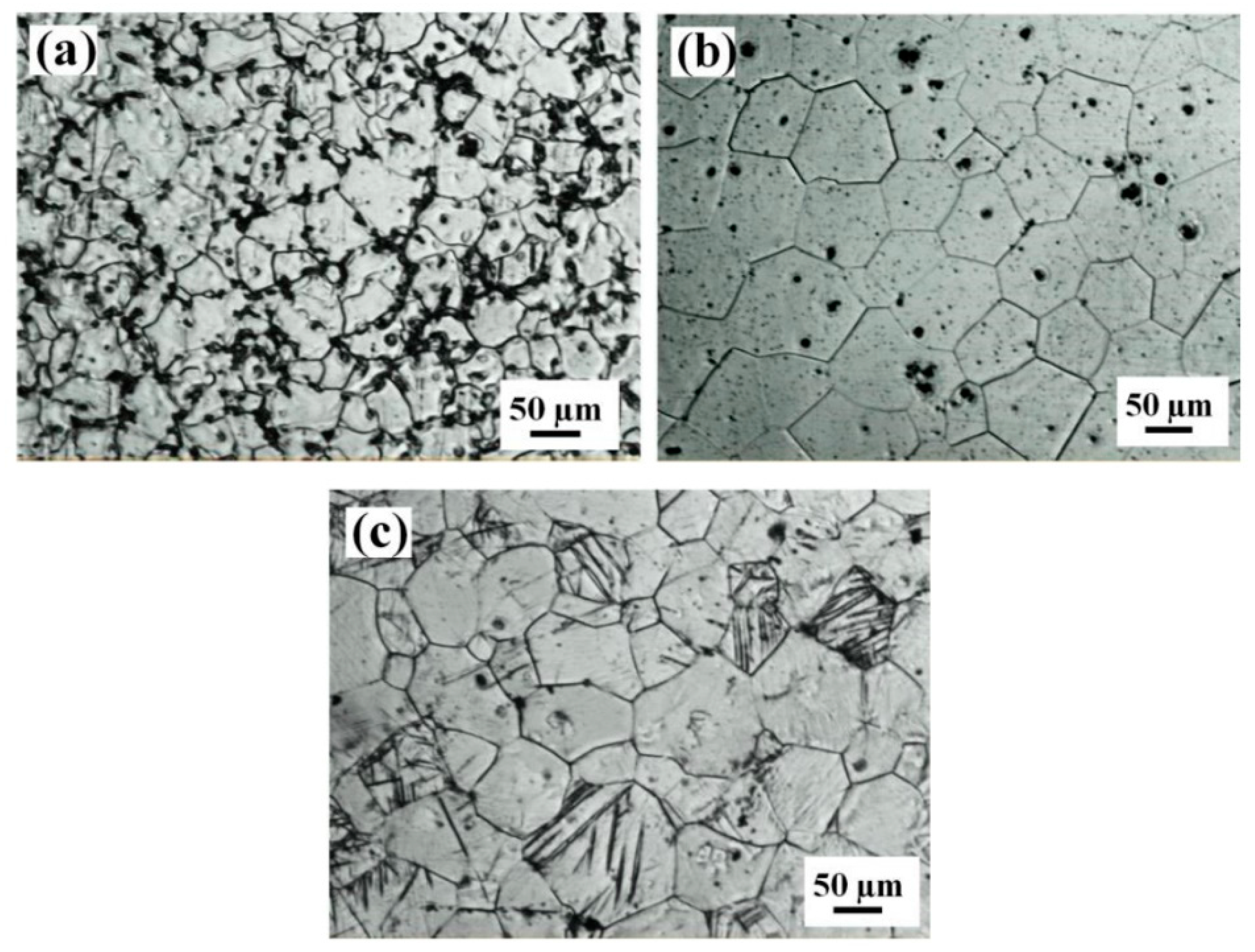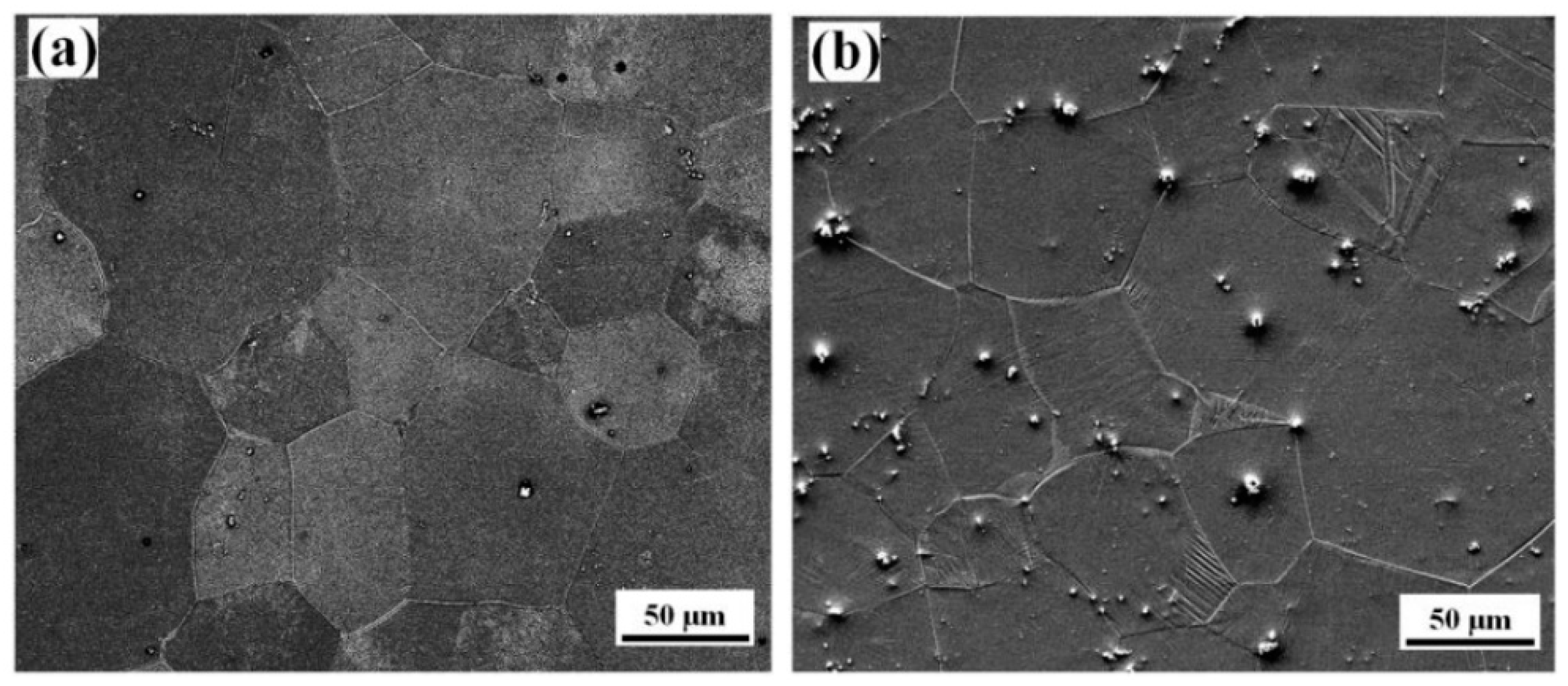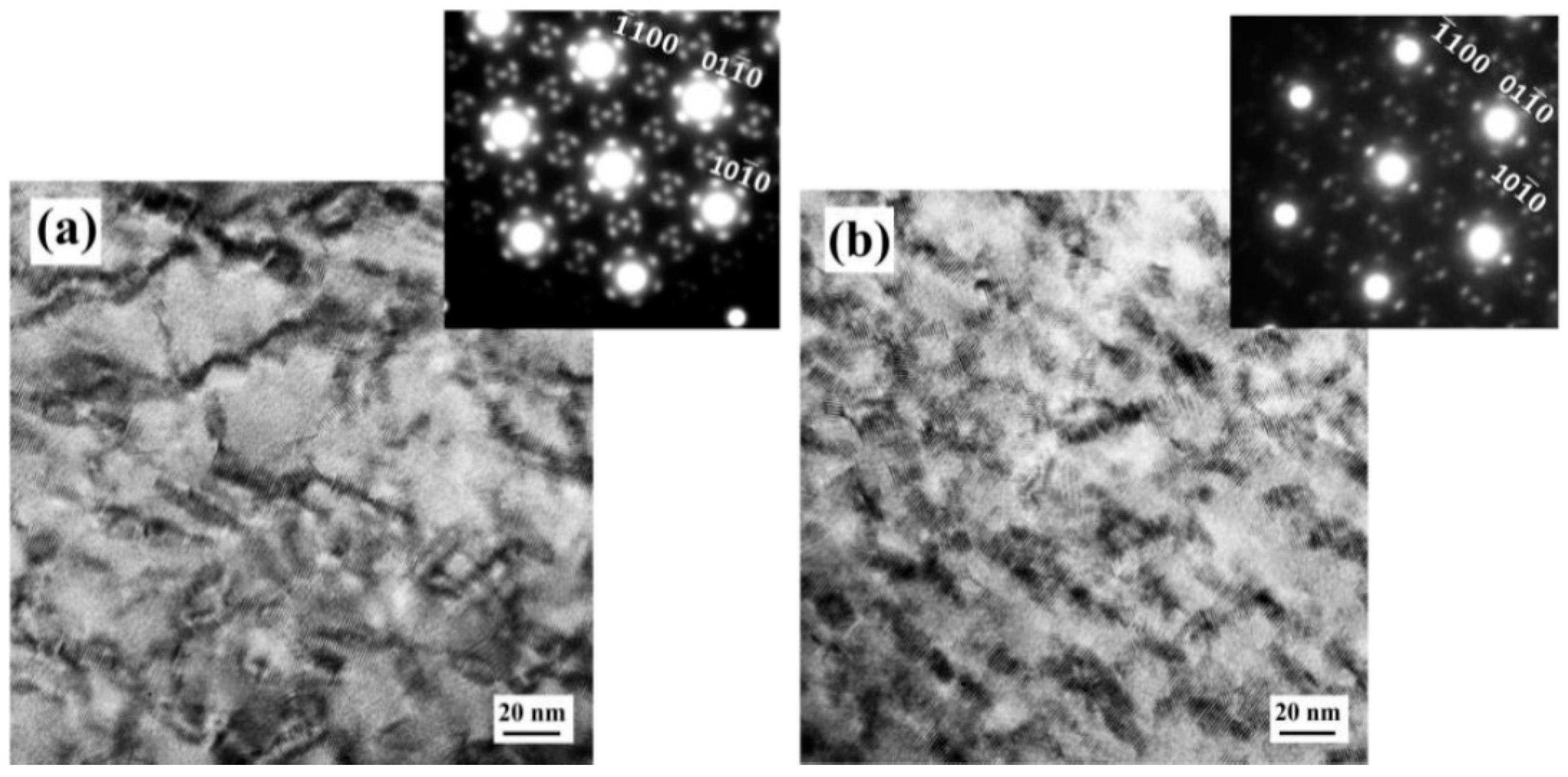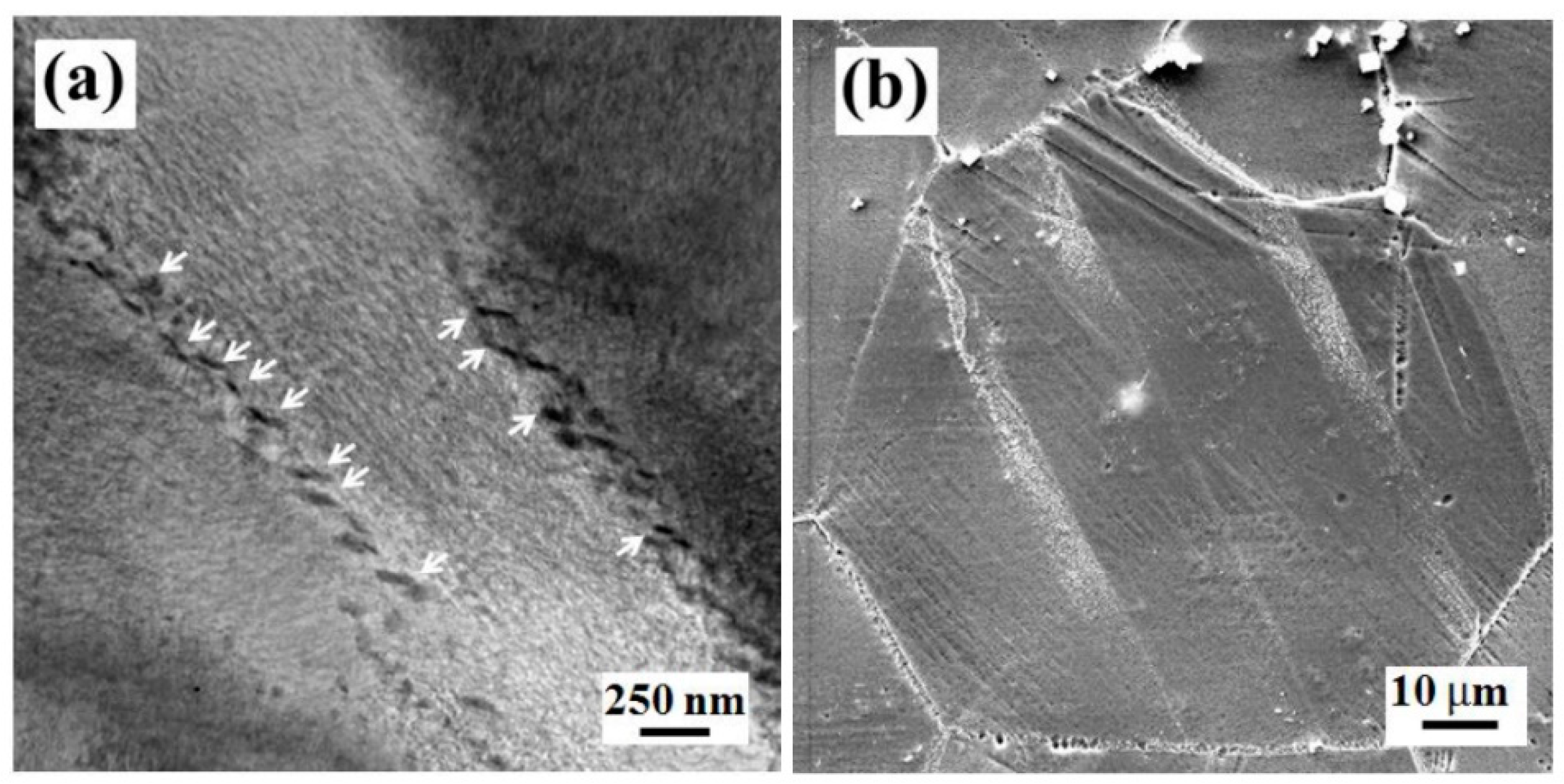Microstructure and High Temperature Tensile Properties of Mg–10Gd–5Y–0.5Zr Alloy after Thermo-Mechanical Processing
Abstract
:1. Introduction
2. Experimental Procedures
3. Results
3.1. Microstructure
3.2. Tensile Properties
3.3. Fracture Behavior
4. Discussion
5. Conclusions
Author Contributions
Funding
Conflicts of Interest
References
- Honma, T.; Ohkubo, T.; Kamado, S.; Hono, K. Effect of Zn additions on the age-hardening of Mg-2.0Gd-1.2Y-0.2Zr alloys. Acta Mater. 2007, 55, 4137–4150. [Google Scholar] [CrossRef]
- Wang, J.; Meng, J.; Zhang, D.; Tang, D. Effect of Y for enhanced age hardening response and mechanical properties of Mg-Gd-Y-Zr alloys. Mater. Sci. Eng. 2007, 456, 78–84. [Google Scholar] [CrossRef]
- Jafari Nodooshan, H.R.; Liu, W.C.; Wu, G.H.; Rao, Y.; Zhou, C.X.; He, S.P.; Ding, W.J.; Mahmudi, R. Effect of Gd content on microstructure and mechanical properties of Mg-Gd-Y-Zr alloys under peak-aged condition. Mater. Sci. Eng. 2014, 615, 79–86. [Google Scholar] [CrossRef]
- Li, K.J.; Li, Q.A. Microstructure and superior mechanical properties of cast Mg-12Gd-2Y-0.5Sm-0.5Sb-0.5Zr alloy. Mater. Sci. Eng. 2011, 528, 5453–5457. [Google Scholar] [CrossRef]
- Mahmudi, R.; Kabirian, F.; Nematollahi, Z. Microstructural stability and high-temperature mechanical properties of AZ91 and AZ91+2RE magnesium alloys. Mater. Des. 2011, 32, 2583–2589. [Google Scholar] [CrossRef]
- Gao, X.; He, S.M.; Zeng, X.Q.; Peng, L.M.; Ding, W.J.; Nie, J.F. Microstructure evolution in a Mg-15Gd-0.5Zr (wt.%) alloy during isothermal aging at 250 °C. Mater. Sci. Eng. 2006, 431, 322–327. [Google Scholar] [CrossRef]
- Golmakaniyoon, S.; Mahmudi, R. Comparison of the effects of La- and Ce-rich rare earth additions on the microstructure, creep resistance, and high-temperature mechanical properties of Mg-6Zn-3Cu cast alloy. Mater. Sci. Eng. 2011, 528, 5228–5233. [Google Scholar] [CrossRef]
- Jafari Nodooshan, H.R.; Liu, W.C.; Wu, G.H.; Alizadeh, R.; Mahmudi, R.; Ding, W.J. Microstructure characterization and high-temperature shear strength of the Mg-10Gd-3Y-1.2Zn-0.5Zr alloy in the as-cast and aged conditions. J. Alloy Compd. 2015, 619, 826–833. [Google Scholar] [CrossRef]
- Jafari Nodooshan, H.R.; Wu, G.H.; Liu, W.C.; Wei, G.L.; Li, Y.L.; Zhang, S. Effect of Gd content on high temperature mechanical properties of Mg-Gd-Y-Zr alloy. Mater. Sci. Eng. 2016, 651, 840–847. [Google Scholar] [CrossRef]
- Yang, Z.; Li, J.P.; Guo, Y.C.; Liu, T.; Xia, F.; Zeng, Z.W.; Liang, M.X. Precipitation process and effect on mechanical properties of Mg-9Gd-3Y-0.6Zn-0.5Zr alloy. Mater. Sci. Eng. 2007, 454–455, 274–280. [Google Scholar] [CrossRef]
- Li, Y.L.; Wu, G.H.; Chen, A.; Jafari Nodooshan, H.R.; Liu, W.C.; Wang, Y.X. Effects of Gd and Zr additions on the microstructures and hightemperature mechanical behavior of Mg-Gd-Y-Zr magnesium alloys in the product form of a large structural casting. J. Mater. Res. 2015, 30, 3461–3473. [Google Scholar] [CrossRef]
- Nie, J.F.; Zhu, Y.M.; Liu, J.Z.; Fang, X.Y. Boundaries periodic segregation of solute atoms in fully coherent twin. Science 2013, 340, 957–960. [Google Scholar] [CrossRef] [PubMed]
- Chen, J.; Wang, Z.Q.; Ma, X.G.; Wang, X.H.; Lei, Y.P.; Yan, W. Annealing strengthening of pre-deformed Mg-10Gd-3Y-0.3Zr alloy. J. Alloy Compd. 2015, 642, 92–97. [Google Scholar] [CrossRef]
- Zhao, S.; Guo, E.; Wang, L.; Wu, T.; Feng, Y. Effect of pre-compressive strain on microstructure and mechanical properties of Mg-2.7Nd-0.4Zn-0.5Zr alloy. Mater. Sci. Eng. 2015, 647, 28–33. [Google Scholar] [CrossRef]
- Zheng, K.Y.; Dong, J.; Zeng, X.Q.; Ding, W.J. Effect of pre-deformation on aging characteristics and mechanical properties of a Mg-Gd-Nd-Zr alloy. Mater. Sci. Eng. 2008, 491, 103–109. [Google Scholar] [CrossRef]
- Adrien, J.; Maire, E.; Estevez, R.; Ehrstrom, J.C.; Warner, T. Influence of the thermomechanical treatment on the microplastic behaviour of a wrought Al-Zn-Mg-Cu alloy. Acta Mater. 2004, 52, 1653–1661. [Google Scholar] [CrossRef]
- Saito, T.; Muraishi, S.; Marioara, C.D.; Andersen, S.J.; RØyset, J.; Holmestad, R. The effects of low Cu additions and predeformation on the precipitation in a 6060 Al-Mg-Si alloy. Metall. Mater. Trans. 2013, 44, 4124–4135. [Google Scholar] [CrossRef]
- Ringer, S.P.; Muddle, B.C.; Polmear, I.J. Effects of cold work on precipitation in Al-Cu-Mg-(Ag) and AI-Cu-Li-(Mg-Ag) alloys. Metall. Trans. 1995, 26, 1659–1667. [Google Scholar] [CrossRef]
- Hamanad, D.; Bouchear, M.; Derafa, A. Effect of plastic deformation on the formation and dissolution of transition phases in Al-12 wt.% Mg alloy. Mater. Chem. Phys. 1998, 57, 99–110. [Google Scholar] [CrossRef]
- Honma, T.; Ohkubo, T.; Hono, K.; Kamado, S. Chemistry of nanoscale precipitates in Mg-2.1Gd-0.6Y-0.2Zr (at.%) alloy investigated by the atom probe technique. Mater. Sci. Eng. 2005, 359, 301–306. [Google Scholar] [CrossRef]
- Jäger, A.; Lukáč, P.; Gärtnerová, V.; Bohlen, J.; Kainer, K.U. Tensile properties of hot rolled AZ31 Mg alloy sheets at elevated temperatures. J. Alloy Compd. 2004, 378, 184–187. [Google Scholar]
- Nie, J.F. Effects of precipitate shape and orientation on dispersion strengthening in magnesium alloys. Scripta Mater. 2003, 48, 1009–1015. [Google Scholar] [CrossRef]
- Kelly, A.; Nicholson, R.B. Strengthening Methods in Crystals; Elsevier Publishing Company: London, UK, 1971. [Google Scholar]
- Ardell, A.J. Precipitation hardening. Metall. Trans. 1985, 16, 2131. [Google Scholar] [CrossRef]
- Nembach, E. Particle Strengthening in Metals and Alloys; John Wiley & Sons: New York, NY, USA, 1997. [Google Scholar]
- Reppich, B. Materials Science and Technology: A Comprehensive Treatment; Wiley-VCH: Weinheim, Germany, 1993; p. 311. [Google Scholar]
- Mabuchi, M.; Higashi., K. Strengthening mechanisms of Mg-Si alloys. Acta Mater. 1996, 44, 4611–4618. [Google Scholar] [CrossRef]
- Avedesian, M.M.; Baker, H. Magnesium and Magnesium Alloys; ASM International: Metal Park, OH, USA, 1999. [Google Scholar]
- Barnett, M.R.; Keshavarz, Z.; Beer, A.G.; Atwell, D. Influence of grain size on the compressive deformation of wrought Mg-3Al-1Zn. Acta Mater. 2004, 52, 5093–5103. [Google Scholar] [CrossRef]
- Wang, H.; Boehlert, C.J.; Wang, Q.D.; Yin, D.D.; Ding, W.J. In-situ analysis of the tensile deformation modes and anisotropy of extruded Mg-10Gd-3Y-0.5Zr (wt.%) at elevated temperatures. Int. J. Plasticity 2016, 84, 255–276. [Google Scholar] [CrossRef]
- Wang, H.; Boehlert, C.J.; Wang, Q.D.; Yin, D.D.; Ding, W.J. In-situ analysis of the slip activity during tensile deformation of cast and extruded Mg-10Gd-3Y-0.5Zr (wt.%) at 250 °C. Mater. Charact. 2016, 116, 8–17. [Google Scholar] [CrossRef]










| Condition | Temperature (°C) | UTS (MPa) | YS (MPa) | EL (%) |
|---|---|---|---|---|
| Un-deformed | 25 °C (RT) | 331 | 241 | 1.1 |
| Un-deformed | 150 °C | 350 | 261 | 4 |
| Un-deformed | 300 °C | 225 | 181 | 15.4 |
| Pre-deformed | 25 °C (RT) | 366 | 293 | 0.9 |
| Pre-deformed | 150 °C | 352 | 306 | 2.6 |
| Pre-deformed | 300 °C | 245 | 200 | 9.4 |
© 2018 by the authors. Licensee MDPI, Basel, Switzerland. This article is an open access article distributed under the terms and conditions of the Creative Commons Attribution (CC BY) license (http://creativecommons.org/licenses/by/4.0/).
Share and Cite
Wu, G.; Jafari Nodooshan, H.R.; Zeng, X.; Liu, W.; Li, D.; Ding, W. Microstructure and High Temperature Tensile Properties of Mg–10Gd–5Y–0.5Zr Alloy after Thermo-Mechanical Processing. Metals 2018, 8, 980. https://doi.org/10.3390/met8120980
Wu G, Jafari Nodooshan HR, Zeng X, Liu W, Li D, Ding W. Microstructure and High Temperature Tensile Properties of Mg–10Gd–5Y–0.5Zr Alloy after Thermo-Mechanical Processing. Metals. 2018; 8(12):980. https://doi.org/10.3390/met8120980
Chicago/Turabian StyleWu, Guohua, H. R. Jafari Nodooshan, Xiaoqin Zeng, Wencai Liu, Dejiang Li, and Wenjiang Ding. 2018. "Microstructure and High Temperature Tensile Properties of Mg–10Gd–5Y–0.5Zr Alloy after Thermo-Mechanical Processing" Metals 8, no. 12: 980. https://doi.org/10.3390/met8120980




